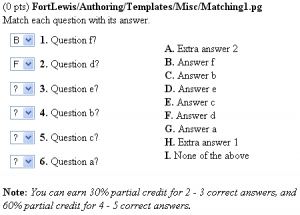Difference between revisions of "Matching1"
| Line 2: | Line 2: | ||
[[File:Matching1.png|300px|thumb|right|Click to enlarge]] |
[[File:Matching1.png|300px|thumb|right|Click to enlarge]] |
||
| − | <p style="background-color:# |
+ | <p style="background-color:#f9f9f9;border:black solid 1px;padding:3px;"> |
This PG code shows how to set up a matching question. |
This PG code shows how to set up a matching question. |
||
</p> |
</p> |
||
Revision as of 19:25, 2 December 2010
Matching Question
This PG code shows how to set up a matching question.
- Download file: File:Matching1.txt (change the file extension from txt to pg when you save it)
- File location in NPL:
FortLewis/Authoring/Templates/Misc/Matching1.pg
| PG problem file | Explanation |
|---|---|
|
Problem tagging: |
|
DOCUMENT(); loadMacros( "PGstandard.pl", "MathObjects.pl", "PGchoicemacros.pl", "PGgraders.pl", "unionTables.pl", ); TEXT(beginproblem()); |
Initialization:
We use |
#
# Create a matching list and use popups
#
$ml = new_match_list();
$ml->rf_print_q(~~&pop_up_list_print_q);
$ml->ra_pop_up_list([
"No answer" => "?",
"A" => "A", "B" => "B", "C" => "C",
"D" => "D", "E" => "E", "F" => "F",
"G" => "G", "H" => "H", "I" => "I",
]);
#
# Add correct questions and answers
#
$ml->qa(
"Question a?", "Answer a",
"Question b?", "Answer b",
"Question c?", "Answer c",
"Question d?", "Answer d",
"Question e?", "Answer e",
"Question f?", "Answer f",
);
$ml->choose(6);
#
# Add extra incorrect answers
#
$ml->extra(
"Extra answer 1",
"Extra answer 2",
);
$ml->choose_extra(2);
$ml->makeLast("None of the above");
|
Setup:
Since we are choosing 6 questions and 2 extra answers and have 1 entry in For more details, see MatchingProblems from the Problem Techniques documentation. |
Context()->texStrings;
BEGIN_TEXT
Match each question with its answer.
\{ ColumnMatchTable($ml) \}
END_TEXT
Context()->normalStrings;
|
Main Text:
The |
$showPartialCorrectAnswers = 0;
#
# Incremental grader
#
install_problem_grader(~~&custom_problem_grader_fluid);
$ENV{'grader_numright'} = [2,4,6];
$ENV{'grader_scores'} = [0.3,0.6,1];
$ENV{'grader_message'} = "You can earn " .
"30% partial credit for 2 - 3 correct answers, and ".
"60% partial credit for 4 - 5 correct answers.";
#
# All or nothing grader
#
# install_problem_grader(~~&std_problem_grader);
ANS( str_cmp( $ml->ra_correct_ans ) );
|
Answer Evaluation:
We must withhold feedback from students by setting If you want a grader that awards full credit when all questions are correct and no credit otherwise, uncomment the standard problem grader. |
@correct = @{$ml->ra_correct_ans()};
$answerstring = join(", ", @correct);
Context()->texStrings;
BEGIN_SOLUTION
${PAR}SOLUTION:$PAR
The correct answers are $answerstring
END_SOLUTION
Context()->normalStrings;
COMMENT('MathObject version.');
ENDDOCUMENT();
|
Solution: It is also possible to provide explanations for these answers. For details, see MatchingProblems from the Problem Techniques documentation. |
